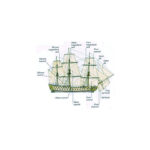The Oamaru was a full-rigged, three-masted iron ship of 1,364 tons gross with dimensions of 239.1’x36.1’x21’. It was built as a long-distance emigrant ship. It was somewhat larger than many of the preceding immigrant ships which plied the Australian and New Zealand emigrant routes, which were often well less than 1,000 tons gross.
The Oamaru was built in 1874 by Scott’s Shipbuilding and Engineering at Greenock, the same port from which the Selwoods departed two years later. Scott’s Shipbuilding was, in its time, one of the largest ship-building operations in the world, having built over 1,250 ships.
The Oamaru was built for the Albion Line, along with its sister ship the Timaru. Later, in 1882, the Oamaru and the Timaru were transferred to the newly established Shaw Savill and Albion Line.
For over 25 years the Oamaru made 24 round trips to New Zealand. This consisted of four trips to Auckland, six trips to Wellington, one trip to Lyttelton, 16 trips to Port Chalmers, and one trip to Bluff. A complete round trip took almost a year. The fastest trip to New Zealand was on her maiden voyage in 1875, taking 78 days from London to Port Chalmers.
The Selwoods were on the second voyage, taking 84 days, under the command of Captain Hood. The Oamaru left Scotland on 23 September 1876, and arrived in Port Chalmers on 16 December with the Selwood family on board. The quarantined ship was then totally cleaned and disinfected and then loaded with bales of wool and sacks of wheat. She left Port Chalmers on 19 May 1877 for London with a small number of passengers on board, arriving in London in August 1877.
There were no established emigrant routes from Britain to New Zealand prior to 1840, but the Treaty of Waitangi in 1840 changed that. Founding shipments went to Auckland and Wellington from 1840, to Port Chalmers (Dunedin) in 1848, and Lyttelton (Christchurch) in 1850. Initially there were inducements offered by private companies and organisations, and these were later introduced by provincial governments, and then by the central government. These inducements included discounts or free passages, loans for part of the cost of travel, employment guarantees, and land grants.
The non-Maori population in New Zealand rapidly changed from under 30,000 in 1853 to over 250,000 by 1870. The Maori population was swamped by the burgeoning European settlements. This was a period of rapid and exciting new growth and opportunity, certainly for the new arrivals. It was fueled by new opportunities in farming, business, and the discovery of gold. It was also helped by the British sending military for what was then called the Maori Wars but probably more appropriately called the British land grab wars, and now known as the New Zealand Wars.
There were well-established procedures in place for the rapidly increasing number of emigrant ships departing for New Zealand and Australia. There would be limitations on the amount of luggage that could be transported. Passengers would be required to provide sufficient clothing, utensils and bedding for the long sea journey. Typically a canvas bag was used to store clothes and supplies in the cabin, and personal trunks were stored in the ship’s hold. Passengers had access to their trunks only once during the trip, mainly when they were entering the colder southern latitudes.
Usually passengers would be given an emigrant guide as to the number and types of clothes they should have available in the cabin. For instance, for an adult woman it was suggested she would need six chemises, six pairs of stockings, two flannel petticoats, two lighter petticoats, two pairs of good boots or shoes, one warm cloak with a hood, and one hat or light bonnet for warm weather.
The ship’s surgeon or doctor would monitor the state of health of passengers while boarding and during the voyage. He (always a he) would set shipboard hours and routines. Usually it was out of bed by 7am, and washing and personal cleaning before the 8am breakfast, after which there would be cabin or deck cleaning duties. Dinner was usually at 1pm and tea at 6pm, and kerosene lights out by 8pm. Afternoons were generally free. Time was spent by some embroidering, reading, writing letters and keeping diaries. Occasional ship-board dancing was very popular. There would be times set for school, religious services, muster drills, and ship inspections.
On emigrant boats like the Oamaru, passengers were restricted in their movements on board. The single men were berthed in the bow, married couples in the middle, and single women in the stern. Single women were somewhat heavily controlled by a matron or the captain, and there was little opportunity for shipboard romance. Even fiancés were separated and virtually had to resort to writing a letter to each other – no cell phones and internet in those days! First or cabin class passengers had more opportunity to move about the ship and had exclusive use of the poop deck.

The route taken to New Zealand by sailing ships was typically to sail way south in the Atlantic Ocean and then pick up the prevailing “roaring 40s” with wind coming from the west, and then heading east sailing well under Africa, then to Australia and New Zealand.
After 24 round trips to New Zealand, the Oamaru was sold in 1905 and renamed the Fox. But soon after that she was abandoned at sea, timber laden, in a storm off the coast of Pensacola, United States.






